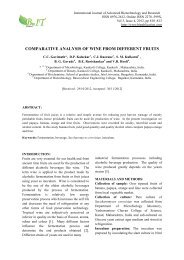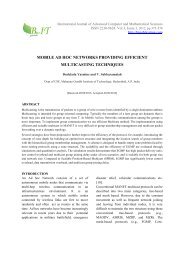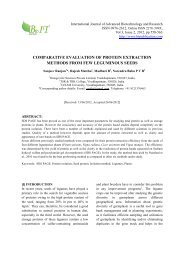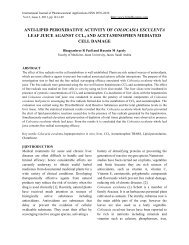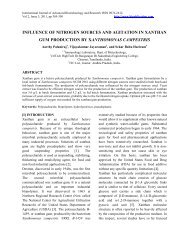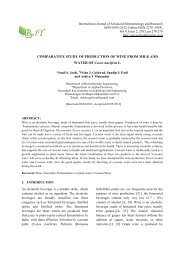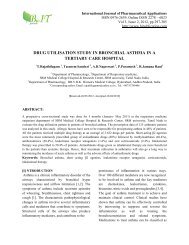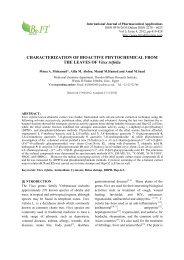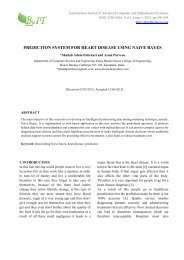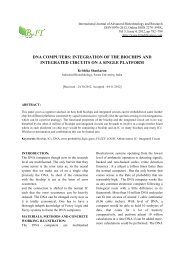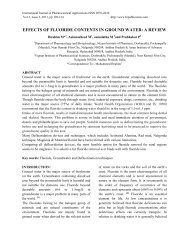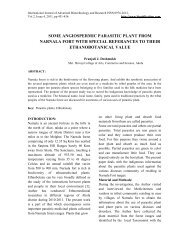kinetic model for extraction of eugenol from leaves - BioIT ...
kinetic model for extraction of eugenol from leaves - BioIT ...
kinetic model for extraction of eugenol from leaves - BioIT ...
Create successful ePaper yourself
Turn your PDF publications into a flip-book with our unique Google optimized e-Paper software.
International Journal <strong>of</strong> Pharmaceutical Applications ISSN 0976-2639.<br />
Vol 3, Issue 1, 2012, pp 267-270<br />
http://www.bipublication.com<br />
KINETIC MODEL FOR EXTRACTION OF EUGENOL FROM LEAVES<br />
OF OCIMUM SANCTUM LINN (TULSI)<br />
ABSTRACT:<br />
D. J. Garkal, S. V. Taralkar * , Prasanna Kulkarni,<br />
Sujitkumar Jagtap, and Archana Nagawade<br />
Chemical Engineering Department, MAEER’s Maharashtra Academy <strong>of</strong> Engineering,<br />
Alandi (D), Pune-412105. Maharashtra. India.<br />
* Corresponding Author: suyogkumartaralkar@yahoo.co.in<br />
Phone no: +912030253500, Fax: +912030253799. Mobile: +919011332500<br />
Herbs are well known <strong>for</strong> their medicinal values and they are used <strong>for</strong> the same purpose since many years. Ocimum<br />
Sanctum Linn (Tulsi) is one <strong>of</strong> the common herbs <strong>for</strong> its various medicinal applications. Eugenol is the important<br />
ingredients found in tulsi. In this work, ef<strong>for</strong>ts have been made to extract <strong>eugenol</strong> by solvent <strong>extraction</strong> <strong>from</strong> tulsi<br />
<strong>leaves</strong>. The extracted samples were analysed with GC <strong>for</strong> determination <strong>of</strong> <strong>eugenol</strong> content. Kinetic <strong>model</strong> has been<br />
used to analyze the experimental data.<br />
Keywords: Eugenol, Ocimum Sanctum Linn, Kinetic Model.<br />
[I] INTRODUCTION<br />
Herb is a plant that is valued <strong>for</strong> flavour, scent,<br />
medicinal or other qualities. Herbs are used in<br />
cooking, as medicines, and <strong>for</strong> spiritual<br />
purposes. Herbs have a variety <strong>of</strong> uses including<br />
culinary, medicinal, or in some cases even<br />
spiritual usage. General usage differs between<br />
culinary herbs and medicinal herbs [1]. Among<br />
the plants known <strong>for</strong> medicinal value, the plants<br />
<strong>of</strong> genus Ocimum belonging to family Labiatae<br />
are very important <strong>for</strong> their therapeutic<br />
potentials. Ocimum sanctum L. (Tulsi), Ocimum<br />
gratissium (Ram Tulsi), Ocimum canum (Dulal<br />
Tulsi), Ocimum basilicum (Ban Tulsi), Ocimum<br />
kilimandscharicum, Ocimum ammericanum,<br />
Ocimum camphora and Ocimum micranthum are<br />
examples <strong>of</strong> known important species <strong>of</strong> genus<br />
Ocimum which grow in different parts <strong>of</strong> the<br />
world and are known to have medicinal<br />
properties. Ocimum sanctum L., known as<br />
‘Tulsi’ in Hindi and ‘Holy Basil’ in English, is<br />
an erect s<strong>of</strong>ty hairy aromatic herb or under shrub<br />
found throughout India. Tulsi is commonly<br />
cultivated in gardens [2].<br />
Leaves <strong>of</strong> tulsi contain number <strong>of</strong> active<br />
ingredients having very good medicinal<br />
value[3,4,5]. Eugenol is an allyl chainsubstituted<br />
guaiacol [3]. Eugenol is a member <strong>of</strong><br />
the phenylpropanoids class <strong>of</strong> chemical<br />
compounds. It is a clear to pale yellow oily<br />
liquid extracted <strong>from</strong> certain essential oils<br />
especially <strong>from</strong> Holy basil (Tulsi) and bay leaf,<br />
clove oil, nutmeg, cinnamon etc. It is slightly<br />
soluble in water and soluble in organic solvents.<br />
It has a spicy, clove-like aroma [6].<br />
Eugenol is used in perfumeries, flavorings,<br />
essential oils and in medicine as a local<br />
antiseptic and anesthetic [7]. It is a key<br />
ingredient in Indonesian kretek (clove)<br />
cigarettes. It was used in the production <strong>of</strong> iso<strong>eugenol</strong><br />
<strong>for</strong> the manufacture <strong>of</strong> vanillin, though<br />
most vanillin is now produced <strong>from</strong> phenol or<br />
<strong>from</strong> lignin. When mixed with zinc oxide,<br />
<strong>eugenol</strong> <strong>for</strong>ms a material which has restorative<br />
and prosthodontic applications in dentistry.<br />
Eugenol derivatives or methoxyphenol<br />
derivatives in wider classification are used in<br />
perfumery and flavoring [8]. They are used in<br />
<strong>for</strong>mulating insect attractants and UV absorbers,<br />
analgesics, biocides, and antiseptics. Several
KINETIC MODEL FOR EXTRACTION OF EUGENOL FROM LEAVES<br />
other pharmacological effects, such as<br />
antitumor, hepatoprotective, anti-inflammatory<br />
(oral & topical), anti-ulcer, antimicrobial, antihyperlipidemic,<br />
and anti-viral activities, have<br />
also been attributed [9]. They are also used in<br />
manufacturing stabilizers and antioxidants <strong>for</strong><br />
plastics and rubbers [10]. It is also used in<br />
mouse traps.<br />
[II] MATERIALS AND METHODS<br />
2.1. Materials<br />
Leaves <strong>of</strong> Ocimum Sanctum Linn. (Tulsi)<br />
collected <strong>from</strong> near by area <strong>of</strong> Alandi, Pune,<br />
Maharashtra, methanol (AR grade) was used as<br />
solvent.<br />
2.2. Batch Extraction setup<br />
The <strong>extraction</strong> <strong>of</strong> <strong>eugenol</strong> was carried out with<br />
batch <strong>extraction</strong> setup (Figure 1). It consists <strong>of</strong> a<br />
500 ml reactor in which <strong>extraction</strong> is to be<br />
carried out; a turbine type four blade agitator<br />
connected with motor (REMI, maximum speed<br />
<strong>of</strong> 1200 rpm) was used.<br />
[III] MATHEMATICAL MODEL<br />
Kinetic Model:<br />
Many reserchers used various <strong>model</strong>s to<br />
describe solid-liquid <strong>extraction</strong> process<br />
[11,12,13] Adamou Harouna-Oumarou et al.<br />
[12] shows, in the study <strong>of</strong> the mechanisms and<br />
<strong>kinetic</strong>s in the <strong>extraction</strong> process <strong>of</strong> water<br />
soluble compounds <strong>from</strong> tilia sapwood, that a<br />
<strong>model</strong> based on a second-order <strong>extraction</strong><br />
process was the most suitable <strong>model</strong> <strong>for</strong> a solid–<br />
liquid <strong>extraction</strong> process. It was then possible to<br />
build the <strong>kinetic</strong> <strong>model</strong>s <strong>of</strong> a solid–liquid<br />
<strong>extraction</strong> and the <strong>extraction</strong> order and rate<br />
constant remained to be determined by<br />
experiments. According to a second-order rate<br />
law Rakotondramasy-Rabesiaka, et. al. [13]<br />
described the rate <strong>of</strong> dissolution <strong>for</strong> the solute<br />
contained in the solid <strong>from</strong> plant cells to solution<br />
by Eq. (6):<br />
------------------- (6)<br />
Where k is the second-order <strong>extraction</strong> rate<br />
constant (L g −1 min −1) , Cs the <strong>extraction</strong> capacity<br />
(concentration <strong>of</strong> solute at saturation in mg L −1 )<br />
and Ct is the concentration <strong>of</strong> solute in the<br />
suspension at any time t (min). By considering<br />
the initial and boundary conditions, t=0 to t and<br />
Ct =0 to Ct, the integrated rate law <strong>for</strong> a secondorder<br />
<strong>extraction</strong> was obtained:<br />
-------------------- (7)<br />
By trans<strong>for</strong>ming Eq. (7), a linear <strong>for</strong>m shown in<br />
Eq. (8) can be obtained and the <strong>extraction</strong> rat<br />
can be written as Eq. (9):<br />
Figure 1: Batch <strong>extraction</strong> setup<br />
2.2. Analysis<br />
Extracted samples were analysed by gas<br />
chromatography technique (GC) with TCD as<br />
detector and capillary column <strong>of</strong> 25 m long. The<br />
oven, injector and detector temperatures were<br />
maintained at 200 0 C. Nitrogen were used as<br />
carrier gas.<br />
(8)<br />
--------------------<br />
------------- (9)<br />
The initial <strong>extraction</strong> rate, h, as Ct/t when t<br />
approaches 0, can be defined as:<br />
----------------------- (10)<br />
and, the concentration <strong>of</strong> solute at any time can<br />
be expressed after rearrangement<br />
S. V. Taralkar, et al. 268
KINETIC MODEL FOR EXTRACTION OF EUGENOL FROM LEAVES<br />
as:<br />
85<br />
------------------ (11)<br />
The initial <strong>extraction</strong> rate, h, the <strong>extraction</strong><br />
capacity, Cs, and the second-order <strong>extraction</strong><br />
rate constant, k, can be determined<br />
experimentally <strong>from</strong> the slope and intercept by<br />
plotting t/Ct versus t.<br />
[III] RESULTS AND DISCUSSION<br />
3.1. Batch Extraction<br />
Fresh <strong>leaves</strong> <strong>of</strong> Ocimum sanctum were washed<br />
under tap water and then kept 36 h <strong>for</strong> drying.<br />
After draying, those <strong>leaves</strong> were cut into small<br />
pieces. 10 g <strong>of</strong> small pieces were weighed.<br />
Those weighed pieces were then fed to the<br />
stirred type batch reactor with 150 ml methanol.<br />
The speed <strong>of</strong> agitation was kept at 500, 700 and<br />
1000 rpm.<br />
The extracted samples at known interval <strong>of</strong> time<br />
was analysed with GC <strong>for</strong> <strong>eugenol</strong> content.<br />
The percentage <strong>of</strong> <strong>eugenol</strong> was calculated <strong>from</strong><br />
the final concentration and the initial<br />
concentration present in <strong>leaves</strong>.<br />
Table 1 shows the percent <strong>extraction</strong> <strong>of</strong> <strong>eugenol</strong><br />
<strong>from</strong> tulsi <strong>leaves</strong> at different agitation speed and<br />
room temperature.<br />
From Figure 2 and table 1, its is clear that as<br />
agitation speed increases the <strong>extraction</strong> <strong>of</strong><br />
<strong>eugenol</strong> also increases this increase in <strong>extraction</strong><br />
is mainly due to the external mass transfer<br />
coefficient. but the values are not that much<br />
higher. The difference is very small.<br />
Table 1: Extraction <strong>of</strong> <strong>eugenol</strong> at 500 rpm<br />
Time<br />
(min.)<br />
Agitation speed<br />
(rpm)<br />
30 500 74.48<br />
60 500 75.74<br />
90 500 76.56<br />
30 700 73.77<br />
60 700 76.67<br />
90 700 77.94<br />
30 1000 75.77<br />
60 1000 78.49<br />
90 1000 80.94<br />
Percent Extraction<br />
(%)<br />
E x tr a c t i o n o f e u g e n o l ( % )<br />
80<br />
75<br />
70<br />
0 20 40 60 80 100<br />
Extraction time (min)<br />
Figure 2: Effect <strong>of</strong> agitation speed on <strong>extraction</strong> <strong>of</strong><br />
<strong>eugenol</strong><br />
3.2 Kinetic Model<br />
Second order <strong>kinetic</strong> <strong>model</strong> was used to describe<br />
the solid liquid <strong>extraction</strong> process <strong>of</strong> <strong>eugenol</strong><br />
<strong>from</strong> tulsi. The <strong>model</strong> was solved and<br />
programmed with Polymath s<strong>of</strong>tware.<br />
Figure 3, 4, 5 shows that the comparison <strong>of</strong><br />
experimental and <strong>model</strong> values <strong>of</strong> concentration<br />
<strong>of</strong> <strong>eugenol</strong> at 500, 700 and 1000 rpm agitation<br />
speed. The <strong>model</strong> values matches with<br />
experimental values with very less difference<br />
and can be neglected in all experiments.<br />
Figure 3: Comparison between experimental and<br />
<strong>model</strong> values <strong>of</strong> <strong>eugenol</strong> concentration at 500 rpm<br />
agitation speed<br />
500 rpm<br />
700 rpm<br />
1000 rpm<br />
S. V. Taralkar, et al. 269
KINETIC MODEL FOR EXTRACTION OF EUGENOL FROM LEAVES<br />
Figure 4: Comparison between experimental and<br />
<strong>model</strong> values <strong>of</strong> <strong>eugenol</strong> concentration at 700 rpm<br />
agitation speed<br />
Figure 5: Comparison between experimental and<br />
<strong>model</strong> values <strong>of</strong> <strong>eugenol</strong> concentration at 1000<br />
rpm agitation speed<br />
[III] CONCLUSIONS<br />
Extraction <strong>of</strong> <strong>eugenol</strong> <strong>from</strong> <strong>leaves</strong> <strong>of</strong> Ocimum<br />
Sanctum Linn (Tulsi) was done with methanol<br />
as solvent. Agitation speed not influencing much<br />
on <strong>extraction</strong> capacity <strong>of</strong> <strong>eugenol</strong>. The <strong>kinetic</strong><br />
<strong>model</strong> used fits very well with experimental<br />
data.<br />
ACKNOLEDGEMENTS<br />
The authors are thankful to AICTE <strong>for</strong> providing<br />
financial assistance in terms <strong>of</strong> MODROD project.<br />
Authors are also thankful to management <strong>of</strong> MAE,<br />
Alandi <strong>for</strong> providing the research facilities to carry<br />
out this work.<br />
REFERENCES<br />
[1] K R, Kirtikar, B D Basu, “Ocimum sanctum in<br />
Indian Medicinal Plants” (Published by LB<br />
Basu, Allahabad), 1965.<br />
[2] Cambridge Advanced Learner’s Dictionary,<br />
Cambridge University Press, headword “herb”.<br />
[3] S. Anandjiwala, J. Kalola, M. Rajani,<br />
“Quantification <strong>of</strong> <strong>eugenol</strong>, luteolin, ursolic acid,<br />
and oleanolic acid in black (Krishna Tulasi) and<br />
green (Sri Tulasi) varieties <strong>of</strong> ocimum sanctum<br />
linn using high-per<strong>for</strong>mance thin layer<br />
chromatography”, J AOAC Int, 89 (6), 1467-<br />
1474, 2006.<br />
[4] J.F. Carris, and K.S.Bhaskar, (1955), (Periodical<br />
Experts Book Agency)Vol 3.<br />
[5] P. D Nadig, S. Laxmi, “Study <strong>of</strong> anti-tussive<br />
activity <strong>of</strong> ocimum sanctum linn in guinea pigs”,<br />
Indian J. Physiol Pharmacol, 49 (2), 243-245,<br />
2005.<br />
[6] P. Prakash, N. Gupta, “Theruptic uses <strong>of</strong><br />
Ocimum Sanctum Linn.(Tulsi) with a note on<br />
<strong>eugenol</strong> and its pharmaceutical actions: A short<br />
review”, Indian journal <strong>of</strong> Physiol Pharmacol,<br />
pg.125-131, 2005.<br />
[7] B.K. Jadhav, K.R Khaandelwal, A.R Ketakr,<br />
S.S. Pisal, “Formulation and evaluation <strong>of</strong><br />
mucoadhesive tablets containing <strong>eugenol</strong> <strong>for</strong><br />
treatment <strong>of</strong> periodontal diseases”, Drug dev.<br />
Ind. Pharma 30, pg. 195-203, 2004.<br />
[8] A. Bennett, I. F. Stam<strong>for</strong>d, I.A. Tavares, S.<br />
Jacobs, F. Capasso, N. Macolo, G. Autore, V.<br />
Romono “ The biological activity <strong>of</strong> Eugenol, a<br />
major constituent <strong>of</strong> nutoncy ; studies on<br />
protsaglandins, the intestine and other tissus.”<br />
Phytotherapy Research, 2, pg. 124-130, 1998.<br />
[9] D.A. Right, J.P. Payne, “A clinical study <strong>of</strong><br />
intravenous anaesthesia with a <strong>eugenol</strong><br />
derivative”, British Journal <strong>of</strong> Anasthesia 34, pg.<br />
379-385, 1962.<br />
[10] Eugenol oil overdose, New York Times Health<br />
Guide.<br />
[11] S. V. Taralkar, D.J. Garkal, “Solid-liquid<br />
<strong>extraction</strong> process <strong>of</strong> active ingredients <strong>from</strong><br />
medicinal plants–mathematical <strong>model</strong>s”,<br />
International Journal chemical sciences and<br />
applications, vol. 1, pg. 82-85, 2010.<br />
[12] H. Adamou, Harouna- Ocmarou, H. Fauduet,<br />
Cambridge Porte, “Kinetic and <strong>model</strong> building<br />
<strong>of</strong> leaching <strong>of</strong> water soluble compounds <strong>of</strong> Tilia<br />
Sapwood”, Separation and Purification<br />
Technology 45, pg. 169-173, 2005.<br />
[13] L. Rakotondramasy-Rabesiak, J. Havet, C.<br />
Porte, H. Fauduet, “Solid-liquid <strong>extraction</strong> <strong>of</strong><br />
protopine <strong>from</strong> Fumaria <strong>of</strong>ficinalis L.-<br />
experimental study and process optimization”,<br />
Sep. and Puri. Tech. 59, 253-261, 2008.<br />
S. V. Taralkar, et al. 270



